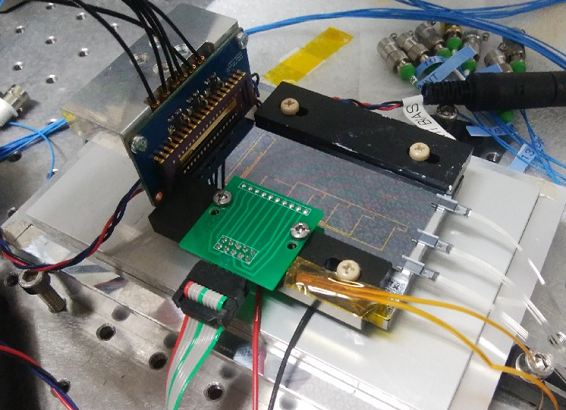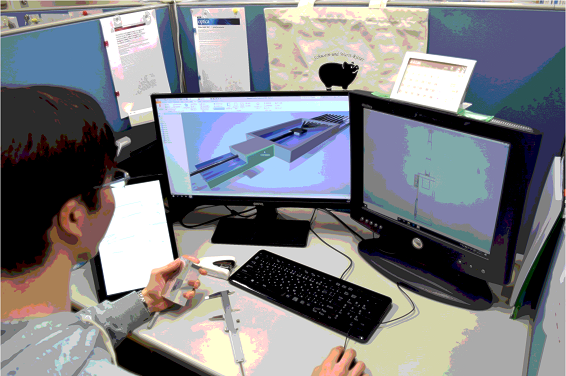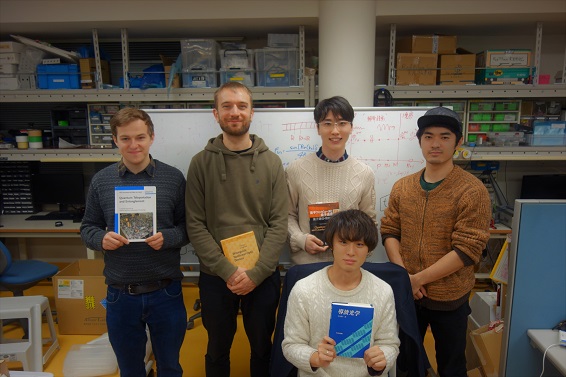The Furusawa Laboratory Waveguide Team (hereafter, the Waveguide Team) is working with Nippon Telegraph and Telephone Corporation (hereafter, NTT) to develop technologies for the practical application of optical quantum information processing (QIP). In the research of optical QIP, the proof of principle of each element tends to attract attention, but the waveguide group is working on research with the keywords of "small" and "fast" for practical use in the future.
In 2015, the Waveguide Team succeeded in integrating the core part of a quantum entanglement generation circuit into an optical chip [1] with NTT. After that we have integrated several circuits [2]. Quantum optics, which had been studied in the 860-nm band, had a problem in integration since the quartz waveguide is lossy at the wavelength of 860 nm. Therefore, in 2019, we shifted to the communication wavelength band (C band) ahead of other teams and established the basis of our experimental know-how on communication wavelength band.
In order to perform high-speed optical quantum information processing, it is necessary to generate special light called squeezed light over a broadband spectrum. However, there has been a trade-off between the band of the squeezed light and the strength of the quantum property, and it has been difficult to increase the band while maintaining the strong quantum property. The waveguide group has been working on the generation of squeezed light with broadband and strong quantum properties in the communication wavelength band since the transition to the communication wavelength band in 2019. In 2019, squeezed light was generated using a small oscillator with high connectivity to a quartz waveguide, and it was confirmed that squeezed light was generated in sideband frequency up to 100 MHz [3]. Furthermore, in 2020, by using a method that does not use an oscillator, we succeeded in generating a squeezing module that achieves both ultra-wide bandwidths of about terahertz and strong quantum in cooperation with NTT [4], and revolutionaries optical QIP studies, which were the mainstay of oscillator research.



- [1] G. Masada, K. Miyata, A. Politi, T. Hashimoto, J. L. O’Brien, and A. Furusawa, "Continuous-variable entanglement on a chip", Nature Photonics 9, 316-319 (2015).
- [2] T. Serikawa, Y. Shiozawa, H. Ogawa, N. Takanashi, S. Takeda, J. Yoshikawa, and A. Furusawa, "Quantum information processing with a travelling wave of light", Proc. SPIE 10535, Integrated Optics: Devices, Materials, and Technologies XXII, 105351B (2018)
- [3] N. Takanashi, W. Inokuchi, T. Serikawa, and A. Furusawa, "Generation and measurement of a squeezed vacuum up to 100 MHz at 1550 nm with a semi-monolithic optical parametric oscillator designed towards direct coupling with waveguide modules", Optics Express 27, 18900-18909 (2019)
- [4] T. Kashiwazaki, N. Takanashi, T. Yamashima, T. Kazama, K.Enbutsu, R. Kasahara, T. Umeki, and A. Furusawa, "Continuous-wave 6-dB-squeezed light with 2.5-THz-bandwidth from single-mode PPLN waveguide", APL Photonics 5, 036104 (2020)
